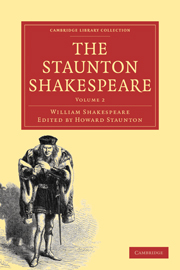Book contents
- Frontmatter
- Contents
- ALL'S WELL THAT ENDS WELL
- KING HENRY THE FIFTH
- AS YOU LIKE IT
- PERICLES, PRINCE OF TYRE
- TWELFTH NIGHT; OR, WHAT YOU WILL
- THE FIRST PART OF KING HENRY THE SIXTH
- THE SECOND PART OF KING HENRY THE SIXTH
- THE THIRD PART OF KING HENRY THE SIXTH
- TIMON OF ATHENS
- KING RICHARD THE THIRD
- MEASURE FOR MEASURE
- KING HENRY THE EIGHTH
- CYMBELINE
KING HENRY THE EIGHTH
Published online by Cambridge University Press: 29 August 2010
- Frontmatter
- Contents
- ALL'S WELL THAT ENDS WELL
- KING HENRY THE FIFTH
- AS YOU LIKE IT
- PERICLES, PRINCE OF TYRE
- TWELFTH NIGHT; OR, WHAT YOU WILL
- THE FIRST PART OF KING HENRY THE SIXTH
- THE SECOND PART OF KING HENRY THE SIXTH
- THE THIRD PART OF KING HENRY THE SIXTH
- TIMON OF ATHENS
- KING RICHARD THE THIRD
- MEASURE FOR MEASURE
- KING HENRY THE EIGHTH
- CYMBELINE
Summary
“The Famous History of The Life of King Henry the Eight” was first printed, it is believed, in the folio of 1623. The date of its production is uncertain. Some editors, including Theobald and Malone, contend that it was written before the death of Elizabeth, and that the complimentary address to her successor—
“Nor shall this peace sleep with her; but as when
The bird of wonder dies, the maiden phœnix,
Her ashes new create another heir,
As great in admiration as herself;
So shall she leave her blessedness to one
(When heaven shall call her from this cloud or darkness)
Who from the sacred ashes of her honour
Shall star-like rise, as great in fame as she was,
And so stand fix'd”—
was interpolated on the play being revived for presentation before King James. Messrs. Dyce, Collier, and others, on the contrary, conjecture it was produced after the accession of James, and in confirmation of this opinion adduce the following Memorandum from the Registers of the Stationers' Company :—
“12 Feb 1604 [1605].
“Nath. Butter] Yf he get good allowance for the Enterlude of K. Henry 8th before he begyn to print it, and then procure the wardens hands to yt for the entrance of yt, he is to have the same for his copy.”
This insertion, supposed by many to refer to Rowley's piece, “When you see me you know me,” which was published in the same year, and is founded on events and characters in the reign of Henry the Eighth, they think pertains to the present play.
- Type
- Chapter
- Information
- The Staunton Shakespeare , pp. 641 - 704Publisher: Cambridge University PressPrint publication year: 2009First published in: 1859

